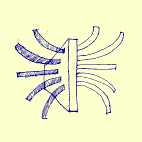
TestALL.org

Articles: |
Thermal Transmittance and Air Permeability of Plain Weave Fabrics |
Author(s): |
Helen H. Epps - Department of Textiles, Merchandising and Interiors, University of Georgia, Athens, GA 30602 Min Kyu Song - Department of Clothing and Textiles, Kansas State University, Manhattan, KS 66506 |
Publication: |
Clothing and Textiles Research Journal, Vol. 11, No. 1, 10-17 (1992) |
Year: |
1992 |
Abstract: |
The findings of earlier research on the influence of particular yarn and fabric structural variables on heat transfer and air flow through fabrics are used in explaining similarities and differences among measurements of air permeability and thermal transmittance of three medium-weight plain weave fabrics. Two fabrics constructed of staple polyester (PET) yarns exhibited higher air permeabilities and lower thermal transmittance values than the third fabric, which was composed of PET filament yarns. Bulk densities of the two staple yarn fabrics were approximately equal, but the fabrics differed in weight, thickness, fabric count, yarn tex, and yarn twist. The staple yarn fabric with the lowest fabric count, highest weight, and highest thickness exhibited the lowest thermal transmittance in both single and multiple layers; however, differences between its thermal transmittance values and those of the thinner, lighter weight staple yarn fabric were not statistically significant. There were significant differences in air permeability between each of the three fabrics. Measurements also were taken on multiple layers of the fabrics. Regression analysis revealed nonlinear declines in thermal transmittance and air permeability as fabric layers were increased. Differences in air permeability and thermal transmittance among the fabrics are explained on the basis of structural differences. |
Text Link: |
Equipment Cited: |
References: |
American Society for Testing and Materials. ( 1986). Annual book of ASTM standards, Vol. 07.01. Philadelphia: Author. Backer, S. (1948). The relationship between the structural geometry of a textile fabric and its physical properties: I. Literature review. Textile Research Journal, 18, 640-658. Backer, S. (1953). The effect of the direction of yam twist and twill on the properties of woven cloth. Journal of the Textile Institute, 44, T477-T479. Backer, S., Zimmerman, J., & Best-Gordon, H.W. (1956). The relationship between the structural geometry of a textile fabric and its physical properties: Part V. The interaction of twist and twill direction as related to fabric structure. Textile Research Journal, 26, 87-107.[Abstract/Free Full Text] Bogaty, H., Hollies, N.R.S., & Harris, M. (1957). Some thermal properties of fabrics: Part 1. The effect of fiber arrangement. Textile Research Journal, 27, 445-449.[Abstract/Free Full Text] Bogaty, H., Hollies, N.R.S., Hintermaier, J.C., & Harris, M. (1953). Nature of a fabric surface: Thickness-pressure relationships. Textile Research Journal, 23, 108-114.[Free Full Text] Booth, J.E. (1968). Principles of textile testing. London: Newnes-Butterworths. Clayton, F.H. (1935). The measurement of the air permeability of fabrics. Journal of the Textile Institute Transactions, 26, T171-T186. Dhingra, R.C., & Postle, R. (1977). Air permeability of woven, double knit and warp knit outerwear fabrics. Textile Research Journal, 47, 630-631. Epps, H.H. (1982). Air permeability of textile fabrics: A comparison of measured and statistically predicted values. ACPTC combined proceedings, p. 212. Epps, H.H. (1988). Insulation characteristics of fabric assemblies. Journal of Coated Fabrics, 17, 212-218. Fonesca, G.F., & Brackenridge, J.R. (1965). Wind penetration through fabric systems. Textile Research Journal, 35, 95-103.[Abstract/Free Full Text] Goodings, A.C. (1964). Air flow through textile fabrics. Textile Research Journal, 34, 713-724.[Free Full Text] Goswami, B.C., Martindale, J.G., & Scardino, F.L. (1977). Textile yarns: Technology, structure, and applications. New York: John Wiley. Hoerner, S.F. (1952). Aerodynamic properties of screens and fabrics. Textile Research Journal, 22, 274-280.[Abstract/Free Full Text] Lamb, G.E.R., & Costanza, P.A. (1979). Influences of fiber geometry on the performance of nonwoven air filters. Textile Research Journal, 49, 79-87.[Abstract/Free Full Text] Latta, B.M. (1977). Comfort finishing of synthetic fabrics. In N. R. S. Hollies & R. F. Goldman (Eds.), Clothing comfort: Interaction of thermal, ventilation, construction and assessment factors. Ann Arbor, MI: Ann Arbor Science. Lord, J. (1959). The determination of the air permeability of fabrics. Journal of the Textile Institute Transactions, 50, 569-582. Morris, M.A. (1955). Thermal insulation of single and multiple layers of fabrics. Textile Research Journal, 25, 766-733.[Abstract/Free Full Text] O'Callaghan, P.W., & Probert, S.D. (1976). Thermal insulation properties of clothing fabrics. Building Services Engineer, 44(7), 71-79. Rainard, L.W. (1946). Air permeability of fabrics. Textile Research Journal, 16, 473-480.[Free Full Text] Rees, W.H. (1941). The transmission of heat through textile fabrics. Journal of the Textile Institute, 32, T149-T166. Robertson, A.F. (1970). Air porosity of open-weave fabrics. Textile Research Journal, 20, 838-857. Scheidegger, A.L. (1974). The physics of flow through porous media. Toronto: University of Toronto Press. Wakeham, H., & Spicer, N. (1949). Pore size distribution in textiles: A study of windproof and water-resistant cotton fabrics. Textile Research Journal, 19, 703-710.[Abstract/Free Full Text] |

This website makes no claim to any trademarked products or copyrighted text contained within.
TestALL+at+gmail+dot+com
TestALL+at+gmail+dot+com
